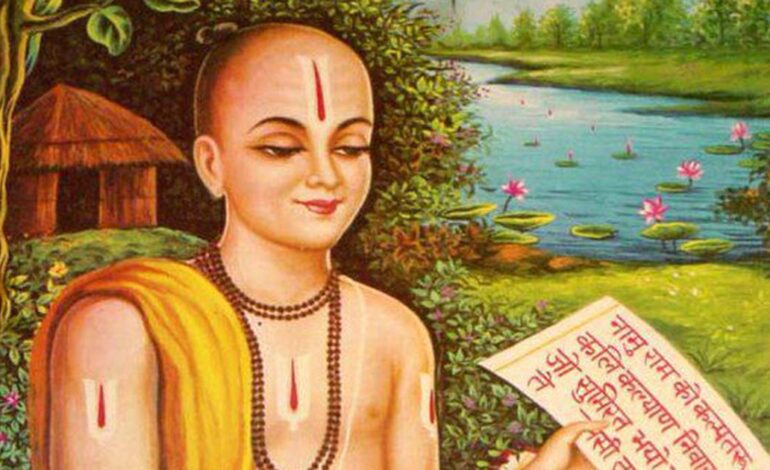
Ramcharitmanas: A beautiful reservoir
By: Rajendra Kapil
The thought of a reservoir conjures an enchanting scene, where pristine water shimmers, a gentle breeze flows, and birds like cuckoos chirp melodiously. The lush greenery all around rejuvenates the heart and soul. At the beginning of Ramcharitmanas, Tulsidas likened this great epic to a reservoir, naming it Ramcharitmanas:
“Ram Charit Manas is its name,
Listening to it brings peace to the ears.
The fire of worldly desires burns the mind,
But peace prevails upon diving into this lake.”
Whoever takes a dip in this reservoir is cleansed of all sins arising from worldly life, becoming pure again. In praise of this great work, Tulsidas states that it is dear to sages and hermits and was composed through the grace and inspiration of Lord Shiva. The story of Ram first resided in Shiva’s heart, who then blessed Tulsidas by infusing it into his heart. For this, Tulsidas offers countless salutations to Lord Shiva:
“Lord Mahesh crafted it in His mind,
And spoke of it at the right time to Goddess Parvati.”
Due to this immense grace, an ordinary being like Tulsidas became the poet of Ramcharitmanas:
“With Lord Shambhu’s blessings, my heart is full of wisdom,
And I, Tulsidas, became the poet of Ramcharitmanas.”
This reservoir has four ghats, or banks, symbolizing four parallel narratives within the epic, each offering one of life’s ultimate goals.
- The first narrative is a dialogue between Shiva and Parvati.
- The second takes place between sages Yajnavalkya and Bharadwaj.
- The third, in the Uttarkand section, features Kakbhushundi and Garuda.
- The fourth is Tulsidas narrating to devotees like us.
The concept of “four” holds great significance. Life’s four goals are Dharma (righteousness), Artha (wealth), Kama (desires), and Moksha (liberation). The opening verse of Hanuman Chalisa also invokes these four fruits of life:
“With the dust of Guru’s feet,
I cleanse the mirror of my mind.
I recount the pure glory of Lord Ram,
Which bestows the four fruits of life.”
The essence of Ram’s story is its sublime fruits. Dharma teaches the art of living; Artha, the means to sustain life; Kama, life’s inherent desires, is guided by Dharma and Artha. Finally, Moksha is the ultimate goal of life. To fulfill these, sages divided life into four stages (ashrams): Brahmacharya, Grihastha, Vanaprastha, and Sannyasa. Even nature aligns with “four,” offering four seasons—Spring, Summer, Autumn, and Winter—and dividing the day and night into four watches.
In this reservoir, the most vital element is its refreshing water, which energizes anyone who dives in. Tulsidas explains that the water of Ramcharitmanas is the sweet glory of Lord Ram and Sita. The verses of the epic are the cool breezes surrounding the reservoir. Its numerous metaphors are like sweet waves, and the hidden meanings in the couplets (chaupais) are pearls hidden in shells. The couplets and stanzas are like lotus flowers, whose nectar is the profound and fragrant meaning within:
“The nectar-like water is Ram and Sita’s glory,
Metaphors dance like delightful waves.
The stanzas, couplets, and verses,
Resemble a myriad of beautiful lotuses.”
Numerous subplots and stories within the epic are like colorful birds—cuckoos and parrots—hovering around this reservoir. The singers, storytellers, and devotees are its guardians, narrating the Ram story only to those who are worthy of hearing it:
“Those who sing and cherish this tale,
Are the skilled custodians of this reservoir.
Men and women who listen with respect,
Are its true and noble recipients.”
Only those who receive Lord Ram’s grace can approach this reservoir. Its sacred water washes away all obstacles and miseries, eradicating the threefold sins—spiritual, divine, and physical—forever.
However, evil and lazy individuals rarely reach this reservoir. Even if they accidentally stumble upon it, they fail to appreciate its beauty, dismissing the cuckoo’s melodious notes as the cawing of crows. Such unfortunate souls miss the blessings of this reservoir and return to spread falsehoods about it.
“Wicked and sinful like herons and crows,
Such unfortunates never approach this reservoir.
Even if they somehow arrive,
They find it hard to dive into its water.
Returning without a dip,
They mock and defame the reservoir.”
Tulsidas also reveals deeper mysteries hidden within Ramcharitmanas. This reservoir emerged in the sacred city of Ayodhya, by the banks of the Sarayu River, in the year 1631 of the Vikram Samvat, on the auspicious Navami day of Chaitra month—the same day that the Vedas describe Lord Ram’s birth.
“In the year sixteen-thirty-one,
I bow to the Lord and begin this tale.
On Navami day in the month of Chaitra,
This story emerged in Ayodhya.”
Tulsidas then turns his attention to the grandeur of the Sarayu River, likening its flowing waters to the joyous events of Ram’s childhood and his divine leelas. Even when the river appears tainted with moss, symbolizing Kaikeyi’s cunning, it remains a sacred stream.
“The moss of Kaikeyi’s malice,
Gives rise to countless calamities.”
For over 450 years, devotees worldwide have cherished the blissful waters of Ramcharitmanas. Those who dive deep into it discover pearls of wisdom, as aptly expressed:
“Seekers find what they desire,
Diving deep into the water’s expanse.
Many pearls and gems they gather,
Becoming wealthy and wise.”
To such a divine creation and to Tulsidas, I offer my humble salutations. As we immerse ourselves in this sacred reservoir, let us exclaim:
Jai Shri Ram!